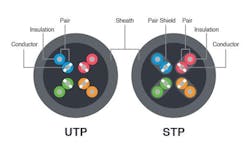Weatherproof Ethernet Connectors and Cabling for Outdoor Applications
Every day thousands of smart devices use Ethernet cables to join the Internet of Things (IoT). Understandably, most of this connectivity happens in benign indoor locations where temperature and moisture levels can be monitored and controlled to ensure optimal operating conditions and extended longevity for these devices. However, the number of smart devices (e.g., cameras, smart lighting, and access points) being designed to operate in uncontrolled environments is steadily increasing.
These robust devices require a communications medium that can handle these conditions equally as well. While wireless protocols might appear to offer an obvious solution, they might not be as reliable (due to localized variations in signal strength) and could be less secure (potential hackers have direct access to the communications medium) than wireline connections.
Even though wireline standards like Ethernet were not initially designed for outdoor use, advances in cabling and connector technology mean that this tried and trusted network protocol can now be used reliably in even the most testing external locations. This article discusses copper cables and new connectors designed for outdoor use that now allow data to travel at gigabit data rates, making them ideal for using Ethernet to connect smart devices to the outdoor and industrial IoT (IIoT).
Ethernet overview
The Ethernet protocol spans Layer 1 (physical) and Layer 2 (data link) of the seven-layer OSI layer model, shown in Fig. 1, and describes how data is framed by multiple devices communicating on the same network segment. It also describes how data is placed on the physical layer medium (PHY). While the earliest versions of Ethernet were designed to use a coaxial cable as the shared network medium, nowadays, typical Ethernet local area networks (LANs) use twisted pair cables to transport data between devices.
Ethernet standards have evolved to enable higher transmission speeds, new functionality like Power Over Ethernet (PoE), and to adopt new media as they have emerged (e.g., optical fiber and new grades of twisted pair cabling). To achieve multi-gigabit data rates while avoiding signal integrity issues, 10G Ethernet employs modulation techniques that carry more than one bit of information per cycle (baud) using lower signal frequencies. In addition, 10G Ethernet employs 16-level pulse-amplitude modulation (PAM16) double square (DSQ) coding, which enables 3 bits per symbol to be transmitted at 833 Mbaud over four twisted wire pairs, allowing a combined bit rate of 10 Gbps.
Bit rate = 833.3 Mbaud × 3 bits per symbol × 4 (pairs) = 10 Gbps
Cabling standards
The Category 6a (or Cat 6a) Ethernet cabling standard further increased bandwidths from 250 to 500 Megahertz (MHz). It also reduced the probability of interference due to crosstalk and enabled faster data transmission rates (up to 10-Gigabits per second) across longer cable lengths. Cat 6a is backward compatible with Category 6 (Cat 6) and legacy Category 5/5e standards. Two versions of twisted pair cable are supported — STP (shielded twisted pair) and UTP (unshielded twisted pair), as shown in Fig. 2.
Connectors standards
The low-cost eight-pin RJ45 connector has long been the mainstay of Ethernet connectivity. However, the original version was designed for indoor applications and did not meet the reliability standards required for outdoor use. Reliability is the most important factor for network operation and becomes even more crucial as the number of devices and sensors increases. As a result, the humble RJ45 has undergone a complete transformation, resulting in the development of new variants that are now suitable for IIoT applications.
Ruggedized RJ45 plugs conform to the IEC 60603-7 standard (for 8-way, unshielded, free, and fixed connectors). They can also withstand shock and vibrations, varying temperatures, and meet the criteria for exposure to various types of liquid.
Summary
As the IoT expands, particularly on the industrial front — and more electronic systems move outdoors — it is imperative that Ethernet connectivity solutions can carry high-speed data that is protected from the elements. Rugged connectors provide robust protection in demanding conditions, allowing Ethernet networks to carry data at rates up to 10 Gigagbits per second and making them ideal for connecting outdoor devices to the IoT.
About the Author

Scott Miller
Scott Miller works for Cinch Connectivity Solutions, a part of Bel Fuse. He has more than 25 years of experience in the electronic components industry working with interconnect manufacturers in harsh environment markets, such as aerospace, defense, and heavy industrial.


